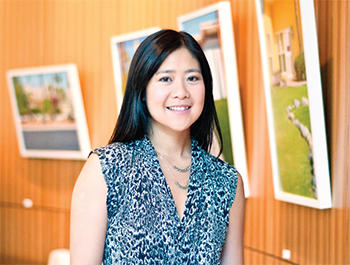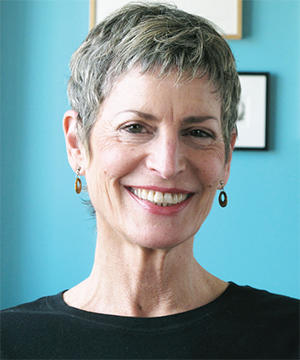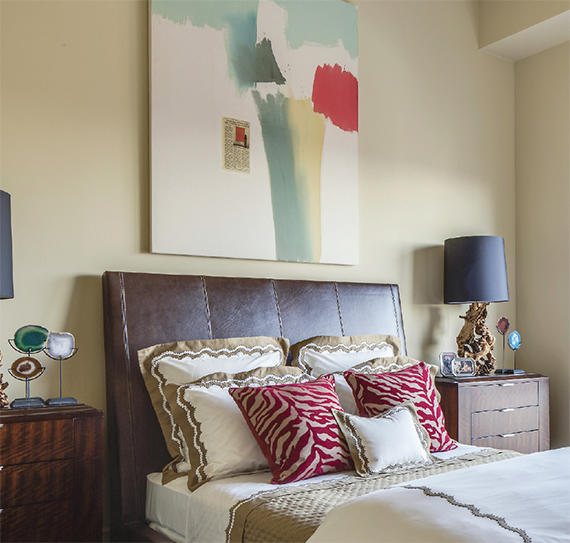Fresh out of Harvard in 2009, Margaret Wang, who then worked in finance, bought a condo on 18th Street in Chelsea. The interior of the previously owned apartment was empty and unadorned at the time of purchase. Though she prefers a minimal aesthetic in home design — white walls are a must — she wanted to include pops of color in the mix.
Still, when it came to decorating the home with art, she needed guidance.
“When you put something on the wall, you commit,” said Wang, who studies at Stanford’s business school and plans to move back to the two-bedroom apartment, now occupied by her sister and a subletter, after she graduates next year. “That was a bit of a hurdle to jump over. I had never hung up an art piece on a wall that wasn’t tacked up.”

Tze Chun
She found help with Uprise Art, an online art gallery that sells pieces by contemporary artists, as well as assists nascent collectors like Wang with making their first investments. In an era of soaring real estate prices — increasingly transforming Manhattan into a realm of one-percenters — there are a number of local services that help well-heeled New Yorkers outfit their spaces and find new roles for themselves as art collectors. Some cater to those who need an education in buying art; others help those who don’t have the time to help themselves. Many of these services — spread among consultants, galleries and installers — report that business is booming more than ever thanks, in part, to the improving economy.
Today, Wang has two pieces from Uprise Art artists proudly displayed in her living room. One is a 30-by-30 painting by artist Anthony Cudahy, which shows a man in a yellow suit and a woman in a striped blouse seated at a table together. The other, atop a bookshelf, is a foot-and-a-half-long sculpture of a tiger shaped out of silk-screened hand-made Japanese paper, whose origami-esque folds were crafted by artist Fay Ku.
“No matter what part of the room you’re in, you’re able to see these artworks,” Wang said.
And thanks to these acquisitions, Wang is now more confident when it comes to buying new work. “It’s definitely helped me become more conversant to communicate what I like,” she said. There are also other pieces in the living space, not purchased from Uprise Art, including some inkblot paintings and a photo print.
Uprise Art was launched in 2011 by Tze Chun, a young entrepreneur who noticed a gap in the art market: There was no real way to start collecting. “You see people who are retired and wealthy, and they have the resources to learn about art collecting,” she said. “I started Uprise Art to make it easier for people to start supporting living artists and doing so by collecting original art. It’s a way to have access into learning about art, living with art and having access to artists who will continue to do great things.”
The art world, said Chun, is legendarily intimidating to navigate. But by bringing a traditional curated gallery online, she aims to make art easier to purchase, as well as more affordable — Uprise Art purchases can be made in installments. The intent is to keep the prices accessible: Most pieces are under $10,000.
The process is very “hands-on,” Chun said. Services include pop-up exhibitions — to connect artists and clients — as well as at-home consultations to brainstorm what to buy and where to install it. For extra busy clients — like lawyers and finance types — these consults can happen in the evening.

Elizabeth Sadoff
Meanwhile, Elizabeth Sadoff, who heads the eponymous, five-year-old Elizabeth Sadoff Art Advisory, similarly helps collectors bulk up their art inventory. She groups her clients — who are generally well-to-do and are referred by interior designers — into types: Those who don’t have time to collect and those who are intimidated by the New York art scene.
“My goal is to engender collections and serial buying,” she said. “There’s the potential for someone to become engaged in looking, acquiring and expanding upon their nascent aesthetic knowledge.”
Sadoff’s artists are generally emerging or mid-career. With their work, Sadoff helps new collectors first find statement pieces for the most important rooms in their homes. “The client and the designer would like to feel that they can settle on one major work where [the client spends] a lot of time,” she said, adding that the goal is to have them feel that “they have a relatively completed project.”
In these locations, Sadoff aims to secure a work on canvas that’s done in a larger scale. Prices can range anywhere from $10,000 to $50,000. Later on, they together can focus on finding smaller works of art for other areas. “It’s an energetic enterprise to reach into someone’s head to see what they like,” she said.

An Upper East Side penthouse that Sadoff worked on with designer James Rixner (credit: Marco Ricca)
Sadoff also occasionally brings clients on gallery and studio tours (for a fee of $125 per hour). She said that looking at art together helps her get to know a client’s taste better. “I can see if they respond or don’t respond,” she said. But there’s another aim to these visits: to inform a sense of pricing. This way, clients “understand why something would be priced at a certain level by becoming a little more familiar with the art market,” she said.
Rob Meyerhoff, an associate at Venable LLP, has a 30-by-40-inch digital photograph print of a modern building displayed over his bed in his East Village apartment — it was his first purchase from Uprise Art. He reached out to them, in part, to learn more about the New York City art scene — something he found impossible to fit into his busy work schedule.
He owns his apartment on the Bowery, and during his earlier days as a renter, he spent time surfing Etsy to see what would fit his space, art-wise. He eventually reached out to Chun in an effort to become “a more targeted art collector,” he said. “As you transition from dorm life to real life, finding quality paintings that you feel comfortable and proud to put in your home is a challenge.”
He has since bought two more pieces from Uprise Art, both in installments: a colorful Anthony Cudahy painting of a woman pinning a yellow flower onto someone’s black lapel, and a painting by Eric Shaw that channels a ’90s minimal look with bold primary-colored lines set atop a background of gray, brown and tan. One is at his work and the other is in his home.
Buying art, of course, is just the beginning. Once you purchase that perfect piece, it’s not just a matter of pounding a nail into the wall and hanging it up. Fortunately, many art advisors and galleries provide installation services, while still other companies specialize in it.

David Kassel
David Kassel, the founder of ILevel, a nearly 30-year-old Manhattan-based art placement and installation service, said there’s an “exact science” to good installation. A big factor is conservation: Watercolor paintings, for example, should not face direct light — nor should any other paper-based art — and works shouldn’t be located near chairs that can pull out and bump against them.
But taste matters, too. ILevel, which has seen a 15 percent year-over-year rise in revenue, said Kassel, also help clients determine where and how their art will work best. The process begins with a “game of solitaire” by leaning hangings against the walls to help envision the potential look. “And finally there’s an ‘a-ha!’ moment and everything seems to have found a home,” he said.
Even those more familiar with the art scene can, at times, use a helping hand. Another expert in the business is the Connecticut-based Troy Fine Art Services, which offers their clients — who are generally more experienced art collectors — assistance in locating specific pieces to add to their existing holdings. “We’re part of the vetting process,” said Troy’s co-founder Denise DiGrigoli.

An installation by ILevel
The overall aim is more holistic: It’s not just finding a particular piece, it’s also helping arrange it with items already on display in the home. “It’s about the relationship,” she said.
